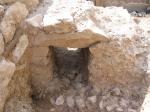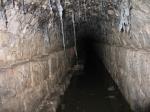Summary (English)
During construction works in the Manuš in Split in the spring of 2005, new important archaeological finds were discovered.
1st section – Remains of a Roman building, parts of which were discovered and partially destroyed by the railroad expansion in 1878, and even more destroyed by the construction of the sewage collector in 1982, and part of the incineration necropolis from the 1st/2nd century was also destroyed.
At a depth of 100 to 180 cm, the remains of Roman walls were visible, the base of a column with a diameter of 50 cm, a large amount of tegulae and imbrices (measured on June 30, 2005: 807 kg in total), plaster, pottery fragments, human bones, glass, and four bronze coins (4th/5th century) were found. In total, four walls oriented north-south and two oriented east-west were discovered. In the western part, a square-shaped channel was preserved, connected to a channel that extends further to the east. Above one of the walls, a stone threshold was found in situ. The width of the walls varied from 55 to 90 cm, while the preserved height in some places was more than 1 m. Numerous finds of archaeological material: numismatic finds, costume elements, remains of interior decoration – marble panelling (red and green porphyry, cipollino, alabaster) and mosaic tesserae.
2nd section – In the west in the Livanjska Street, numerous archaeological remains were also discovered: one pottery bowl laid upside down in the cremation layer (thickness 12-13 cm) above the Roman floor, iron nails, pottery fragments and two mosaic cubes. Already in 1983, the remains of this Roman building (more than 180 m2) were unearthed.
3rd section – In Kliška Street, in 1979, during the construction of a kindergarten, the remains of a Roman building and a pithos were discovered. A part of the destroyed foundation made of waterproof mortar, placed on a stone structure, which stretched north and south, was discovered, along with numerous finds of pottery fragments, the most numerous being amphorae.
4th section – In Kliška Street, north-south direction, there is a part of the aqueduct channel, renovated during the Austro-Hungarian era, and today in the function of the city’s sewage system is located (Elvira Šarić, Tajma Rismondo 2006, Hrvatski arheološki godišnjak 2/2005, 402–404).
- Elvira Šarić
- Tajma Rismondo
Director
- Elvira Šarić
Team
Research Body
Funding Body
- Grad Split
- HEP






![Download [PDF]](/excavation/skins/fasti/images/results/download_sml.png)

